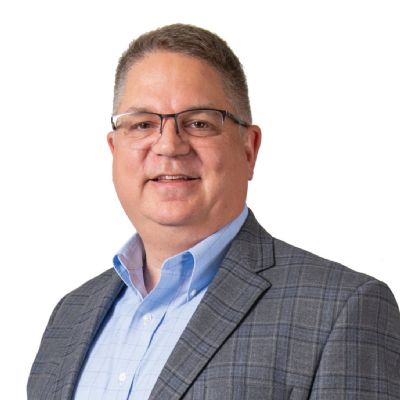Founded on Goals and Objectives that Live On Today
According to its constitution, PMI’s stated goals were:
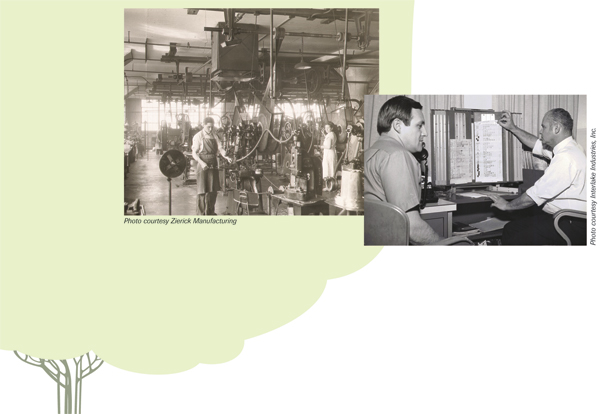 • To promulgate the use of pressed metal through education of manufacturing industries and others as to the advantages they may gain by its use.
• To promulgate the use of pressed metal through education of manufacturing industries and others as to the advantages they may gain by its use.
• To establish cordial personal relations between manufacturers of pressed metal products.
• To devise s means to promote a feeling of good will between the manufacturers and their customers.
• To devise a means of promoting better working conditions for the employee.
• The mutual study of cost accounting systems and the costs of manufacture.
• To improve and develop commercial methods in the manufacturing and marketing of pressed metal products.
• To obtain and diffuse information on general trade matters.
• To establish s and means of holding regular group meetings at such time and places as conditions warrant.
• To cooperate with all government agencies and departments and other organizations in standardization and association activities.
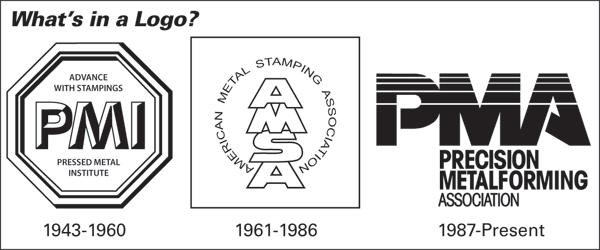 |
| The Pressed Metal Institute (PMI) formed in 1942 with 42 charter member companies, and adopted as its logo an octagonal shield representing its eight major services—management, technical and research programs, education and training, safety, meetings, public relations, statistics and government liaison. In 1961, PMI—going strong with 190+ member companies—became known as the American Metal Stamping Association (AMSA), and adopted a new logo, this one a circle representing a more flexible overall program. Membership grew to more than 1000 companies by 1987, when AMSA evolved into the Precision Metalforming Association. |
Soon after officially organizing in Ohio, PMI further defined its objectives and purposes:
• To consider, deal with and secure group opinion and action on the common management problems of the stamping industry and on any questions, policies and techniques that may be involved in those problems.
• To advance the lawful common purposes of its members and to promote and safeguard the interests of the industry as a whole.
• To foster equity in business usages; and to formulate, promote and develop programs and activities designed to assist producers of stampings to operate with the greatest economy and efficiency.
• To provide a proper, practical, efficient means of maintaining contacts between government and the industry.
• To promote a helpful, sympathetic relationship between the industry and the public and to improve the industry’s commercial and industrial relationships.
• To cooperate with other industries and organizations.
• To do everything necessary and proper for the accomplishment of any objects herein set forth or which shall be recognized as proper and lawful objectives of nonprofit trade associations, all of which shall be consistent with the public interest, as well as in the interest of this industry and trade.
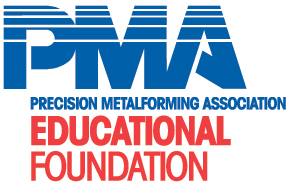
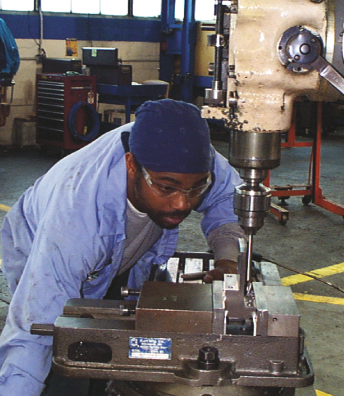 PMAEF was established in 1996 to support and develop training and education for metalforming skills, and to improve the public image and awareness of careers in metalforming. It raised more than $2 million in an endowment campaign, the majority of which was pledged between 1997 and 2000. Since that time the foundation has made more than $1 million in grants to support its mission. PMAEF was established in 1996 to support and develop training and education for metalforming skills, and to improve the public image and awareness of careers in metalforming. It raised more than $2 million in an endowment campaign, the majority of which was pledged between 1997 and 2000. Since that time the foundation has made more than $1 million in grants to support its mission.
|
The association also sought to collect and disseminate trade statistics and other factual data and information of interest and value to the industry and the public; to conduct research into markets; and to handle trade inquiries. Unfair trade practices received attention back then, as they do today. And so did efforts to promote apprentice training and make other attempts to educate and train those connected with or interested in becoming affiliated with the industry. PMI members worked then, as do PMA members today, to promote and protect the industry’s interests in public and governmental matters and to secure adequate presentation of its problems before governmental, economic and business groups.
Onward and Upward
On March 1, 1949, the officers of PMI entered into a joint operation with the National Screw Machine Products Association. Later that year, the association’s board of directors established the following committees: Executive, Finance, Statistics, Industrial Relations, Industry Mobilization, Technical Research and Standards, Public Relations, Sales, and Education. Districts within PMI also were defined and the duties of district officers outlined.
PMI held its first National Technical Meeting in Cleveland, OH, on March 16-17, 1950. Another first that year: PMI published its Blue Book of Stamping Manufacturers, which listed all member companies and was distributed to some 15,000 purchasers of metal stampings. The book later became known as the Annual Stamping Buyer’s Guide.
In 1951, PMI issued its first Industry Mobilization Survey, as well as its first Wage and Hour Survey. Another emphasis that year was on international trade, as PMI officials visited England under the sponsorship of the Economic Cooperation Administration. Later that year, American stamping plants were visited by the Belgian Forging and Stamping Team. And, at PMI’s Annual Meeting that year, held at the Drake Hotel in Chicago, board members were treated to a presentation on the English government’s regulations on safety. As a result, PMI agreed to launch its own safety committee.
In 1955, PMI terminated its arrangement with the National Screw Machine Products Association. Industry awards became a focus for the association that year, as its Spring Technical Meeting featured the first-ever presentation of the John Woodman Higgins Redesign Award. The $500 cash award was presented by the Worcester Pressed Steel Company, Worcester, MA, in memory of its founder, to recognize a metal stamper for excellence in product design. The award, which lives on today as the Higgins-Caditz Design Award, went to engineers from General Electric’s appliance group in Louisville, KY, for redesign of integral back plates and a drain trough for GE’s combination refrigerator-freezer.
Branching Out
Improved communications with member companies came into focus for PMI in 1957 with the issuance of the first Stamper’s Digest, a collection of articles of interest to stampers. Also that year, PMI joined the International Deep Drawing Group.
PMI membership during this time averaged slightly less than 200 companies, until January of 1961 when Jefferson D. Keith was appointed PMI’s managing director and increasing membership became job one. By 1972, membership grew under Keith’s direction to nearly 500 companies.
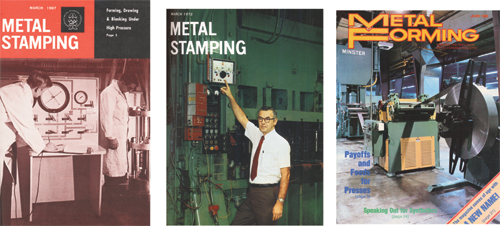
|
| March 1967 marked the birth of AMSA’s industry publication, Metal Stamping magazine. On the cover (shown) of that inaugural issue: equipment employed for pilot forming of metals under high pressure at Northeastern University, Boston, MA. Metal Stamping went all-color exactly 5 years later, with its March 1972 issue—shown at left is an Atwood plant engineer pointing out the control installed on a production press. The magazine became MetalForming with its June 1988 issue, whose cover showcased a servo-driven roll feed and 400-ton Minster press operating at Pax Machine Works in Celina, OH. |
1961 also saw another major change for PMI, when the association formally became the American Metal Stamping Association (AMSA), so that its name would more accurately describe the industry it served. PMI’s logo at the time was an octagonal shield representing its eight major services—management, technical and research programs, education and training, safety, meetings, public relations, statistics and government liaison. In 1961 a new logo took hold, this one a circle representing a more flexible overall program. AMSA undertook an expanded public-relations program, which continued to bring results. Included was the introduction of the Stamping Guide. AMSA also that year took over the Small Lot Institute, which became a division of AMSA. C.W. Cederberg of Larson Tool & Stamping Company, Attleboro, MA, became AMSA president at the Annual Meeting. That meeting also spawned the association’s first networking group, the “20 Year Breakfast Club,” comprised of companies that had belonged to AMSA/ PMI for 20 years or more.
Growing an International Presence
International affairs took flight in 1964, as the first International Study Team of 47 AMSA representatives toured plants in Germany, France and England, and then attended the First International Stamping Conference in England. In 1965, AMSA established a precedent by cosponsoring a two-day conference of Educators and Industrialists, at Kent State University. It established other precedents that same year when it participated in the National Safety Congress, and also marketed itself to potential members by reserving a booth for the first time at the ASTME (American Society of Tool and Manufacturing Engineers, now known as SME) Tool Show. Also in 1965, AMSA took first place in the 1965 National Idea Fair of the American Society of Association Executives.
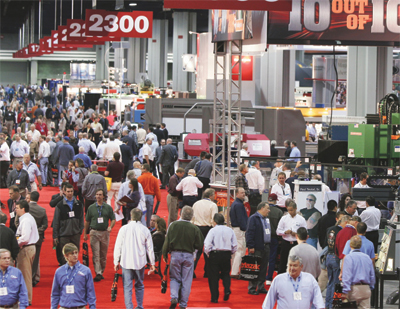 AMSA launched its first METALFORM tradeshow for the metalforming industry in 1981 as a tabletop exhibition in Cleveland, OH. In 1983 METALFORM became a full-fledged exhibition held every two years in Rosemont, IL. The idea to make the exposition annual and also move it out of the Midwest exclusively took root in 1992, when PMA made METALFORM an every-year event. Rosemont hosted METALFORM during odd years, and the show landed in Nashville, TN in even years. AMSA launched its first METALFORM tradeshow for the metalforming industry in 1981 as a tabletop exhibition in Cleveland, OH. In 1983 METALFORM became a full-fledged exhibition held every two years in Rosemont, IL. The idea to make the exposition annual and also move it out of the Midwest exclusively took root in 1992, when PMA made METALFORM an every-year event. Rosemont hosted METALFORM during odd years, and the show landed in Nashville, TN in even years.
In 2001, PMA and the American Welding Society (AWS) launched a joint tradeshow called MAX International, held in Cleveland. In 2002, METALFORM reverted back to a standalone exposition as PMA decided to hold the show in Rosemont during odd years and to produce a downsized regional METALFORM during even years. In 2008 METALFORM merged with the FABTECH and AWS Welding Show, rebranded as FABTECH in 2010. In addition to FABTECH, PMA also participates in an annual tradeshow in Mexico, where it co-locates its METALFORM Mexico show (launched in 2004) with AWS Weldmex and FABTECH Mexico. |
In 1966, the AMSA publication Metal Stamper evolved into a semi-monthly newspaper, Metal Stamping Highlights, and work was started on a new monthly magazine for publication early in 1967 to be called Metal Stamping (which later became known as MetalForming). Metal Stamping published its first issue in March 1967, with advertising support from a few companies who endure to this day, including Wintriss Controls, Precision Steel Warehouse, Cooper Weymouth and Minster Machine Co. Also in 1967, AMSA began its 25th year, marking its Silver Anniversary Year by signing an On-the-Job Training Program contract with the U.S. Department of Labor.
In 1969, AMSA hosted the Third International Technical Conference of Sheet Metal Working, at the Sheraton Hotel in Chicago. This international technical meeting was sponsored by AMSA as well as trade associations from England, France and Germany. More than 250 international delegates attended from 12 countries, in addition to a U.S. delegation of more than 850. This meeting represented AMSA’s first attempt at multilingual, simultaneous translation as well as printing. Each program was presented simultaneously in French, English, German and Japanese.
In 1970 and 1971 the focus shifted notably to safety, as AMSA’s 22nd annual technical conference placed a heavy emphasis on complying with new government-mandated safety-code requirements (the Occupational Safety and Health Act of 1970, and the establishment in 1971 of the Occupational Safety and Health Administration). In 1971 AMSA initiated the Seastrom Safety Award, founded by the Seastrom Manufacturing Company of Glendale, CA, in memory of its founder W. H. Seastrom. The award lives on today, sponsored for PMA’s Awards of Excellence in Metalforming program by the Pitcher Insurance Agency as a to recognize innovative and effective safety programs.
Training in the metal stamping industry also was emphasized by AMSA in 1971. A series of two-day workshops was held for key employees responsible for their companies’ compliance with the new safety regulations. In conjunction, AMSA compiled its first safety-compliance handbook.
In 1972, AMSA broke ground for a new headquarters’ building in Cleveland (Richmond Heights), and the association’s technical meeting moved out of the United States for the first time, as more than 900 stampers met in Toronto, Ontario, Canada.
Also in 1972, Metal Stamping magazine proudly published its first four-color cover.
A Major Rebirth
AMSA became very active in government relations in the early 1970s, with the inception of OSHA. Association membership doubled in the early 1970s as a result. In the late 1970s, AMSA joined with other industry groups, including the Precision Machined Products Association and the National Tooling and Machining Association (NTMA), to form the Alliance of Metalworking Industries (AMI). This group lobbied and testified before Congress on issues affecting the industry. 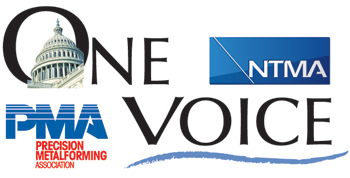 AMSA formed a political-action committee (PAC) in 1977, primarily to support challengers and congressional races where there were open seats. The philosophy was to focus on change in order to elect a pro-business and pro-manufacturing Congress. The AMSAPAC became the Precision Metalforming Association Political Action Committee (PMAPAC) in 1987, before becoming PMAVIC (PMA Voice of the Industry Committee) in 1995. AMSA formed a political-action committee (PAC) in 1977, primarily to support challengers and congressional races where there were open seats. The philosophy was to focus on change in order to elect a pro-business and pro-manufacturing Congress. The AMSAPAC became the Precision Metalforming Association Political Action Committee (PMAPAC) in 1987, before becoming PMAVIC (PMA Voice of the Industry Committee) in 1995.
AMI weakened and eventually dissolved in the 1980s, as the association found little reason to lobby during the Reagan years. Although PMA continued to be involved in government relations and lobbied before Congress on a handful of issues, it significantly ramped up its lobbying efforts in 2001 as the steel tariffs arrived. At the summer 2003 PMA board of directors meeting, the board decided to place a strong emphasis on lobbying, and in 2004 PMA hired full-time lobbyists to strengthen our industry’s voice in Washington. In 2008, PMA joined forces with NTMA to lobby as One Voice for the metalworking industry. Ever since, PMA has continued to increase its footprint in Washington, D.C., growing its presence with members of Congress, the Administration and the media. |
We hope you enjoyed reading this colorful timeline that traces the first 30 official years of AMSA—PMA’s roots. Modern history for the association, “and a major rebirth,” says current PMA president Bill Gaskin, “occurred in 1975 when Jon Jenson took the reigns as AMSA president. AMSA had a staff of 14 at the time, and Jenson recommitted their time and energy toward a few key competencies that really drove the association’s growth for many years to come.”
Those three key areas receiving Jenson’s attention: Metal Stamping magazine, government affairs and industry statistics.
“Jon Jenson really professionalized AMSA,” Gaskin adds.
Among the early moves made under Jenson’s direction was the creation, in 1977, of the AMSA political-action committee. Also in 1977, AMSA created a new committee (joining its Technical Research Committee and Government Affairs Committee) to compile and deliver industry statistics to member companies. Among the early statistical reports created are the Business Conditions Report and Orders and Shipments Report—both still offered to members today.
Along with its committees, PMA also operates several industry-specific divisions, related to metal spinning (PMA’s first division, formed in 1975); Washer Manufacturing; Slideforming (formed in the mid-1980s); Small-Lot Stamping and Fabrication; Custom Rollforming (initially its own association founded as the Custom Roll Forming Institute in 1972, and becoming a PMA division in 1992); Tool and Die (established in 1999); Next Generation (PMA’s newest division, formed in 2006); and—of course—Metal Stamping, the largest of PMA’s divisions. The stamping division formed shortly after AMSA became the Precision Metalforming Association, in 1987, to better reflect the industry it served. PMA announced the name change at the association’s tradeshow, METALFORM, held in March in Chicago. As explained in an article in the March 1987 issue of Metal Stamping:
“It was necessary to redefine the industry to be served by the association—to recognize and adapt to the obvious technical and business trends sweeping the industry…as companies seek to become more flexible and provide more value-added operations…This trend is already reflected in the association’s membership, where some 20 percent of the manufacturing members are primarily metal fabricators and metal spinners, rather than stampers.”
In 1988, Metal Stamping magazine took the name MetalForming. Both changes were in recognition of the evolution of so many metal stampers throughout the 1970s and 80s. Describing the reason for changing the magazine’s name, its editor and PMA president Jenson wrote (in the June 1988 issue):
“More than ever before, the metalforming industry—the industry that gives utility to sheetmetal by shaping it with tooling in machines—is blending various types of metalforming operations. Technologies that were traditionally separate are being merged. The metalforming industry includes contract metal stampers; end-product or captive metal stampers; perforators; precision sheetmetal fabricators; metal spinners; four-slide users; rollformers; tool and die shops with production presses; and suppliers of equipment, materials and services. These fields have common customers, common suppliers and similar legislative and regulatory concerns. They shape the same type of materials by similar and related methods.”
Training Takes on a New Look
In 1988 PMA released its first video-based training system to train industry employees setting up and operating manually fed presses, and in 1989 a program was released for training on coil-fed presses. These have been followed over the years by training systems for setting and operating press brakes and metal-spinning machines, as well as a Spanish version of the coil-fed training system, and an updated version (in 1999) of the coil- and manually fed systems. Training systems have also been developed for safety, dimensional variation, lock-out tag-out, and economic literacy.
In 1993, PMA began work on creating a skill-standard credentialing system for all of the metalworking industry, which transformed itself into the National Institute for Metalworking Skills (NIMS) in 1995. Also in 1993, the PMA Stamping Division launched its annual Automotive Parts Supplier Council meeting, which will celebrate its 20th anniversary in 2013.
PMA’s Next Generation division formed as PMA president Gaskin acted on the vision of 2005 PMA chairman Dennis Keats, from Su-Dan Corp. The group was designed for up and coming leaders in metalforming. Activities of the division are open to anyone from a PMA member company who is considered an emerging leader within their company. The group has recently formed a senior-level executive networking group for next-generation leaders, which will hold its first meeting in Nashville in June 2012.
In 2009, PMA attracted 14 women to its inaugural Women in Metalforming gathering at Fabtech in Chicago, IL. The group hosted a roundtable at the NTMA/PMA Annual Meeting in 2010, and in 2011 it executed a Partnering with Horses Leadership Program at the Pebble Ledge Ranch in Novelty, OH. In 2011 the group supported the first annual Women in Manufacturing event, held in October in Cleveland, which attracted more than 130 women manufacturing leaders who discussed best practices in manufacturing, mentoring, communication strategies and leadership.
Anticipating and Planning for the Future
At the conclusion of AMSA’s 30th anniversary historical look-back, editors wrote:
“We shall not write 30 to this history, because 30 means the end. We are too busy planning our 31st year and anticipating the programs of our 50th year.”
Well, I too will not put a number to this history, as PMA and MetalForming are too busy planning the 71st year and anticipating our 100th year. MF
See also: Precision Metalforming Association
Technologies: Bending, Management
 Brad Kuvin
Brad Kuvin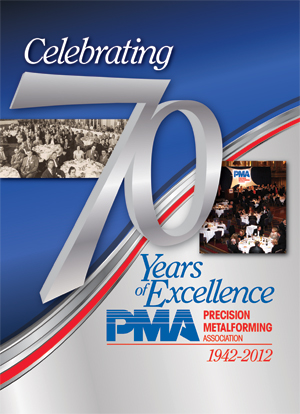 Late in 1942, a series of letters and unofficial meetings launched the Pressed Metal Institute (PMI), the direct ancestor of today’s Precision Metalforming Association (PMA). Organized officially in Cleveland, OH, with 42 charter member companies, PMI and the industry it represented—the metal-stamping industry—faced a sizable public-image problem. That image problem is best summed up in the following excerpt from a letter delivered early in 1943 to a steel-industry executive by PMI member C. C. Caditz, Northern Metal Products Company, Franklin Park, IL:
Late in 1942, a series of letters and unofficial meetings launched the Pressed Metal Institute (PMI), the direct ancestor of today’s Precision Metalforming Association (PMA). Organized officially in Cleveland, OH, with 42 charter member companies, PMI and the industry it represented—the metal-stamping industry—faced a sizable public-image problem. That image problem is best summed up in the following excerpt from a letter delivered early in 1943 to a steel-industry executive by PMI member C. C. Caditz, Northern Metal Products Company, Franklin Park, IL:













 Podcast
Podcast